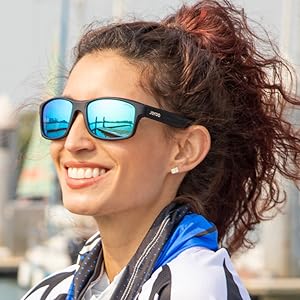Cycling is an exhilarating activity that combines fitness, adventure, and the great outdoors. However, to fully enjoy your ride, it's essential to have the right gear, and cycling sunglasses are a crucial part of that. Not only do they protect your eyes from hurtful UV rays, but they also enhance visibility and comfort in various weather conditions. In this blog post, we'll explore how to choose the perfect pair of cycling sunglasses based on different weather scenarios.

Cycling Sunglasses for Sunny Conditions
When the sun is shining brightly, the right sunglasses can make a world of difference. For sunny conditions, look for sunglasses with dark-tinted lenses, such as smoke or brown. These lenses reduce glare and provide excellent UV protection, which is crucial for preventing eye strain and long-term damage. Polarized lenses are also a great option as they minimize glare from reflective surfaces like roads and water. Additionally, ensure that your sunglasses have a UV400 rating to block out 100% of UVA and UVB rays.

Cycling Sunglasses for Overcast or Cloudy Weather
Overcast or cloudy weather might seem less demanding, but it still requires specific lens types for optimal visibility. In these conditions, lenses with a lighter tint, such as yellow or amber, are ideal. These lenses enhance contrast and depth perception, making it easier to spot obstacles and changes in the terrain. Photochromic lenses, which adjust their tint based on the light conditions, are also a versatile choice for variable lighting.

Cycling Sunglasses for Rainy Conditions
Riding in the rain presents a unique set of challenges, and your sunglasses need to help, not hinder, your vision. The key here is to reduce glare and maintain clear visibility despite the raindrops.
Clear or lightly tinted lenses are ideal for rainy conditions. Clear lenses protect your eyes from debris and raindrops without altering your vision. They can also come with an anti-fog coating, which is essential in humid, rainy weather. If you prefer a slight tint, go for yellow or amber lenses, which enhance contrast and make it easier to see through the gloom.
Anti-reflective coatings are particularly beneficial in rainy conditions. They reduce glare caused by wet surfaces, like the road, which can reflect light and create distracting reflections. A hydrophobic coating is also a valuable feature, as it helps rainwater slide off the lenses, maintaining clear vision even in a downpour.

Cycling Sunglasses for Low-Light or Night Riding
Cycling in low-light conditions or at night requires maximum visibility and protection. Clear lenses are the go-to option for these scenarios as they allow the most light to reach your eyes⁷. Some clear lenses come with anti-reflective coatings to reduce glare from oncoming headlights and streetlights. It's also beneficial to choose sunglasses with a wraparound design to protect your eyes from wind and debris.

Cycling Sunglasses for Variable Weather Conditions
Weather can be unpredictable, especially if you’re cycling for long distances or in areas with rapidly changing conditions. For these situations, versatility is key.
Photochromic lenses are the go-to choice for variable weather. These lenses adapt to the changing light conditions, darkening in bright light and lightening in low light. This adaptability ensures that you’re always wearing the right tint, no matter what the weather throws at you.
Alternatively, consider sunglasses with interchangeable lenses. These allow you to swap out lenses depending on the conditions. While it requires carrying extra lenses, it offers the ultimate flexibility. With this option, you can always have the ideal lens for different weather, from bright sunshine to sudden downpours.






